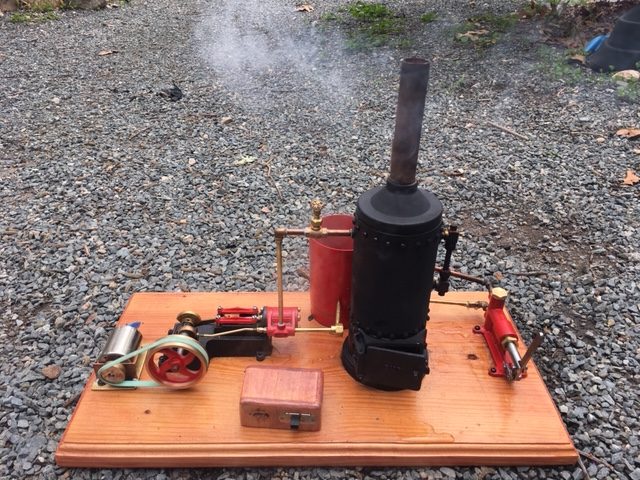As part of my 8th grade curriculum at the Meadowbrook Waldorf School, I needed to undertake a project of my choosing. Working with Tim Straw, my mentor and a volunteer at the museum, I constructed a model steam plant. It is a combination of kits and scratch-built items. In the course of my work, I used a metal lathe to machine several parts from scratch (a bushing, screw set, and T fitting). I used a blow torch and flux to silver solder several joints. Using my woodworking skills and a router, I created a custom base for the steam plant. I also painted the model with metal paint to give the whole model a unified, custom look. After the plant was built, I conducted pressure tests to ensure tight seals in the boiler and steam lines, and worked with the generator to ensure a reliable flow of electricity. At the end of the project, I showed the results of my work, including a video of it running on steam, and gave a talk to an audience of peers, parents and community members.
 Overall, I was very happy with how the project turned out. I owe a massive thanks to Tim Straw, my mentor, for guiding me through the process of building it and helping me solve issues. He encouraged me to take my time, create a good design, and prepare materials well, which resulted in a high-quality project that I can be proud of.
Overall, I was very happy with how the project turned out. I owe a massive thanks to Tim Straw, my mentor, for guiding me through the process of building it and helping me solve issues. He encouraged me to take my time, create a good design, and prepare materials well, which resulted in a high-quality project that I can be proud of.
My talk is summarized below.
–Adrian Gvosdev Kranz
The Refurbished Engine
I started by washing all of the parts in a degreaser liquid. I made new seals and reassembled it before painting it. Then I machined a new bushing and screw set for the connecting rod.
The Boiler
I started by taking the 4-inch diameter pipe and drilling 1/16 rivet holes then took a ¼ in drill bit and drilled the holes for the threaded adapters. I then took the copper pipe for fire tubes and cut 13 lengths at 4.5 inches. After sanding these I started fitting the tubes into the tube sheet. This proved extremely difficult because every time I lined up a tube or two the third would cause the other two to pop out. When I finally got all the tubes in the sheet, I used a blowtorch to silver solder the pipes to the sheet. The copper had to have flux on it and be at 800 oF to flow and create a strong bond. Then I joined the outer 4-inch pipe with the inner assembly with rivets and more solder. The final step was to attach the cast aluminum parts like the door and base with screws.
The Boiler Pump
In order to feed the boiler with fresh water a small high-pressure pump is employed. I got it as a kit, and I assembled and painted it.
The Water Tank
The water tank was cut from an old propane tank. It was sanded and painted before holes were drilled for the water lines.
The Generator
The Generator is a small motor that is spun from a pulley on the steam engine to make 10 volts and operate a USB charger. In the future, in the event we lose electricity, I can still charge my phone using the steam engine.
The Plumbing
The plumbing is a mix of ¼ inch copper pipe and 3/16-inch brass pipe. I machined a brass T fitting for the return line.
The Base
The base was built from a salvaged stair board. I first cut it to size and then used a router to add a nice bevel. The base was then stained and clear coated.
The History of the Steam Engine
The steam engine was the source of power for everything from factories to boats and power plants for almost 150 years. Even today, nuclear submarines and power plants still use updated versions of steam engines.
The first steam engine was built by Hero of Alexandria, Egypt during the first century AD. It consisted of a copper sphere that was suspended on both sides over a fire. When water was poured in and allowed to boil, the steam produced would be ejected out of nozzles causing the sphere to spin. This device was used as a demonstration, and Hero never realized that it could do work.
In the 1600s, steam devices were used to pump water but they were not true “engines” because they had no pistons and generated no force.
Steam engines as we know them today were invented and patented by James Watt in 1775. His design was improved greatly over the years but the core remained the same. The last big step was the steam turbine which was invented in 1884 by Sir Charles Parsons. His design is still in use today.

